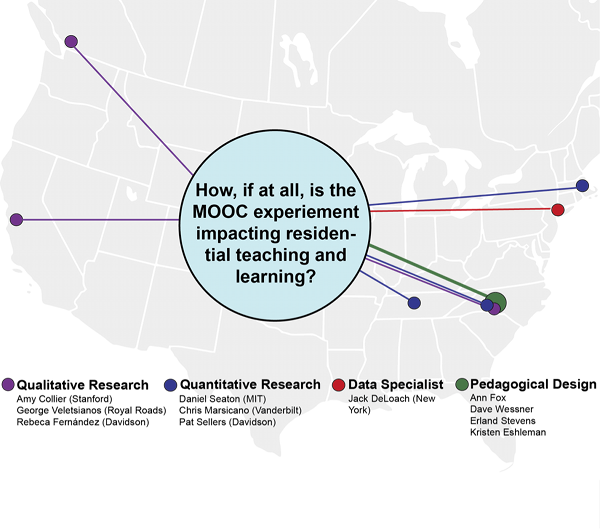You have /5 articles left.
Sign up for a free account or log in.
This post is the second in a four-part series on MOOC research at Davidson College. We began with “why”, laying out the rationale for leading with a qualitative and residentially focused study. Attending to Davidson students' learning experiences and designing hybrid education has been a primary goal of our research efforts.
We continue here with “how”, describing the collaborative design process that is shaping our evolving philosophy on networked research. Our design process centers on the following question:
How might networked research efforts help higher education respond to the rapid pace of technological change and the evolving needs of modern learners?
A DesignJam Approach to Our Research
For our MOOC experiment, we chose a design process that would harness the power of collaboration. As we uncovered in a 2014 gathering at UT-Arlington, collaboration drives innovative thinking about the potential for networks within and among higher ed institutions. We settled on a similar process that leverages the potential for new networks to increase our individual capacity for delivering and researching large-scale learning.
Davidson College possesses neither a dedicated research staff nor a Graduate School of Education where learning research might naturally occur in larger institutions. However, constraints breed creativity, and small liberal arts schools with limited resources are accustomed to these challenges as well as designing innovative approaches to amplify capabilities.
To aid us in designing good educational research questions, we reached out to the orchestrators of some of the best models for qualitative research: Amy Collier and George Veletsianos. On the heels of a presentation at the ELI 2014 conference and a subsequent conversation at SXSWEdu, we asked them to collaborate with us in forming a DesignJam for the DavidsonX study. Our small sample size and a student body versed in reflective practice made Davidson an ideal qualitative case study.
We kicked off the collaboration with a two hour jam session aimed at narrowing our research questions and discussing best practices for gathering the data. The Davidson team met face to face, while the rest of the team joined via web conference. We recorded everything using Google Docs, and continued iterating on these docs asynchronously once the research focus became clear. Below is a graphical representation of our DesignJam team - where we reside and the expertise we contributed. A subset will continue with the analysis:

The goal of the DesignJam was to bring together diverse perspectives to the questions posed for research. More information on the design of the study can be found on our DavidsonX blog, where we welcome suggestions for participation on future iterations.
Collective Intelligence & Networked Research
In Social Physics, Alex Pentland quantifies the ideas that are central to the success of the MIT Media Lab and of other innovative and effective networks. Collective intelligence and the success of any community, he argues, will stem from the flow of ideas. Idea flow is a combination of exploration and engagement that requires elements of diversity, trust, cooperation and social interaction.
The DavidsonX research collaboration is symbiotic and efficient. As a group we can more effectively identify the gaps in existing research, resource the expertise for data collection and analysis, guard against interpretive bias, and include a broader range of perspectives toward deeper understandings of teaching and learning. DavidsonX research will continue efforts in a networked way, seeking out partners with similar goals in mind.
Where Should Digital Learning Research Go From Here?
Higher education research is often anything but collaborative. It can be a cutthroat competition for professional recognition. Competing in this way runs counter to Pentland’s research and assertion that “the best ideas come from careful and continuous social exploration”.[1]
A recent initiative, Digital Learning Research Network (dLRN) - funded by the Bill and Melinda Gates Foundation - reflects the need to rethink openness and collaboration in research. The grant brings together two distinct groups: R1 research systems with high research capacity and state institutions with high research opportunities. Often in learning sciences, basic research remains in the domain of peer discussions, rather than moving into Pasteur’s method of scientific research that has practical and relevant application. The intent of dLRN (http://linkresearchlab.org/dlrn/) is to bring together top researchers with high impact research opportunities and to do so in a way that is transparent and brings opportunities for external and global collaboration.
Techno-cultural pressures influence scholars to reconsider some of the foundational principles of their work. Tools, behaviors, and cultural expectations are leading the shift to networked forms of scholarship. Responding to the needs of modern learners in a time of rapid change requires the harvesting of multiple diverse ideas combined with cooperative research teams that can react to and iterate on those ideas toward consensus. Our best defense against forces of disruption may be a well-designed offense of networked, cooperative educational R&D. We hope that the model of research we are adopting at Davidson becomes a broader practice in higher education.
[1] Pentland A. Social Physics, How Good Ideas Spread-the Lessons from a New Science, (Penguin Press; 2014), 24.
Kristen Eshleman is Director of Instructional Technology at Davidson College.







